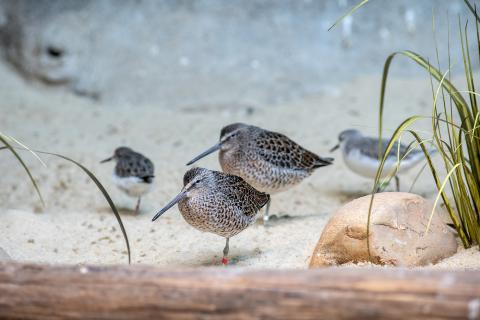Physical Description
The Panamanian golden frog is a small, brightly colored, frog-like toad. Its head is longer than it is broad with a pointed, protuberant snout.
Its body is slim with long limbs. Its back is smooth and yellow with "X" shaped or variable black blotches, and its belly is uniformly yellow. Both male and female Panamanian golden frogs have similar coloration and patterns.
This species' skin is toxic in the wild; glands on the skin produce tetrodotoxin and a unique compound called zetekitoxin. The skin of a single Panamanian golden frog contains enough toxins to kill 1,200 mice. Its vibrant, yellow color is aposematic, meaning it warns potential predators of its toxicity.
Size
Adult males measure between 3.5 and 4.8 centimeters and weigh 3-12 grams. Females measure between 4.5 and 6.3 centimeters and weigh 4-15 grams. Wet forest males and females are larger than dry forest frogs.
Native Habitat
Panamanian golden frogs live in two types of habitats: wet forest streams and dry forest streams. They inhabit streams along the slopes of the Central Cordilleran rainforests and cloud forests of western-central Panama, from 1,100 to 4,300 feet (335 to 1,315 meters) above sea level.
Lifespan
Little definitive information exists on the life span of the Panamanian golden frog, but most estimates put life span between 10 and 15 years.
Communication
Males attract females with visual displays, instead of calling like most male frogs and toads do. These attractive displays include leg and head twitching, stamping the ground and hopping in place. Male frogs often wave their arms to communicate with females whom will wave back if interested.
Food/Eating Habits
The Panamanian golden frog is predominantly an insectivore. Its diet consists mostly of insects and other small invertebrates. They use their eyes to find prey and hunt during the day.
Adult Panamanian golden frogs at the Zoo are mostly fed fruit flies, bean beetles and crickets. In the early stages of development, froglets eat springtails.
Sleep Habits
Panama golden frogs are diurnal, or active during the day.
Reproduction and Development
Panamanian golden frogs reproduce mainly along streams and other sources of moving water. During mating, the female deposits 30 to 80 eggs in long strings in shallow water, as the male fertilizes them. These large clutches of eggs increase the chance that at least a few juvenile toads will survive to adulthood.
Tadpoles have a flattened body and an abdominal sucker, which keeps them from being swept away in the current. They are completely white for the first few days after hatching, then darken to green with black spots after a few weeks. This cryptic coloration helps them hide in fast-moving streams. As they mature and grow, the green pigment turns yellow, advertising their toxicity to predators.
Conservation Efforts
The International Union for Conservation of Nature's Red List of Threatened Species classifies the Panamanian golden frog as critically endangered. These toads were once fairly common and had been seen in the wild as recently as 2005 but have since all but disappeared throughout their northern range. They are assumed to be rare or extinct on Cerro Campana and have been extinct at El Valle de Antón for more than 40 years.
Panamanian golden frogs have been catastrophically affected by chytridiomycosis, an emerging disease caused by an aquatic fungal pathogen, called amphibian chytrid fungus. Populations in El Copé disappeared over the course of just a few months in late 2004. In recent years, there has been a continued drastic decline in this toad's population, and no individual has been seen in the wild throughout its historic range since 2009.
Threats to this species include habitat loss and fragmentation, over-collection for the pet trade, and most notably, chytridiomycosis (amphibian chytrid fungus). Emerging disease is the greatest threat facing these toads today.
The Smithsonian's National Zoo and Conservation Biology Institute was a the forefront of identifying amphibian chytrid fungus and continues to be involved with the Panamanian Golden Frog Species Survival Program (SSP), a collaboration between zoos and NGOs. The program works to protect the golden frog, as well as 12 other at-risk species of amphibians in Panama through the Panama Amphibian Rescue and Conservation Project (PARC). Through research and maintaining an assurance population of frogs in human care, including Panamanian golden frogs, the SSP hopes to avoid their extinction.
The team is also leading an effort to find new ways to combat amphibian chytrid fungus in order to someday return these amphibians to their historic ranges in the wild. Additionally, geneticists and animal care staff at the Zoo are working together to develop methods to safely collect and store genetic material from these at-risk amphibians, to help ensure the genetic diversity of future populations.
Help this Species
- Be a smart consumer. Choose products made with sustainable ingredients, such as Smithsonian certified Bird Friendly coffees, which support farmers striving to limit their impact on wildlife and habitat.
- Practice ecotourism by being an advocate for the environment when you’re on vacation. During your travels, support, visit or volunteer with organizations that protect wildlife. Shop smart too! Avoid buying products made from animals, which could support poaching and the illegal wildlife trade.
- Support organizations like the Smithsonian’s National Zoo and Conservation Biology Institute that research better ways to protect and care for this animal and other endangered species. Consider donating your time, money or goods.
Meet the Animals
Animal News

Leaf-tailed Gecko Treated for Skin Cancer With Chemotherapy





